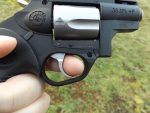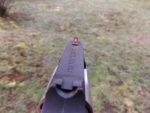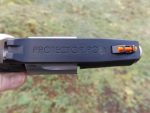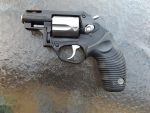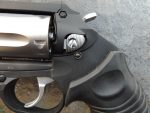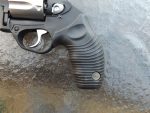My wife and I were forced, by circumstances beyond our control, to move back to the Chicago, IL area in 1982. We stayed until the middle of 1984, at which time we moved to Colorado Springs, CO. While back in Chicago, I went to work for a large private detective agency that I had worked for in the past. I was the manager of the Investigations Division, and I not only supervised a good number of Investigators I also oversaw all the big cases from the many branches we had around the country. I was also the company gunsmith and maintained all the company’s handguns, many of which were Taurus 4” Bbl .38 Spl revolvers with a mix of similar Smith & Wesson revolvers. I kept a good supply of parts for the Taurus handguns on hand at all times. Back then, in my humble opinion, Taurus wasn’t producing the best revolvers; they were always breaking.
Believe it or not, Taurus has been around since 1941, when they started business down in Brazil, South America. Today, we have Taurus USA, and they handle all of the sales of Taurus firearms in the USA. Taurus started out producing near clones of the S&W Model 10, .38 Spl revolvers, as well as the Beretta Model 92. Again, they were near clones. Most parts will not interchange between the Taurus guns and the S&W and Beretta guns. Still, Taurus was copying some outstanding firearms to start with, and they were economical. They still are!
I hear some complaints about current Taurus firearms from those saying they are turning out a lot of lemons. Well, I’ve discussed this, in the past, with the former President of Taurus USA, and according to their records they have about a 1% return rate on new handguns, which is well below the return rate of many gun makers. It just appears that Taurus has a lot of “bad guns” because they sell so many. They are a leader in the western world, when it comes to firearms. So, don’t believe everything you hear or read on the Internet.
I will relate a bad experience I had with a brand new Taurus Model 85, little 5-shot snubby revolver. I purchased it brand new at a local gun shop, and I examined the gun closely, or so I thought. The fit and finish was perfect, and I cocked the hammer and dry-fired the gun with no problems. When I took the gun out to actually shoot it and I attempted to fire the gun by pulling the trigger in the double-action mode, I could not. As hard as I tried, I could not get the trigger to pull and fire the gun. I could cock the hammer manually and fire the gun, but I couldn’t pull the trigger. I sent the gun back to Taurus, because they have a lifetime repair policy, and had it back in three weeks. What happened was, there was a machining operation that got missed, and the trigger couldn’t be pulled in the double-action mode! Obviously, someone missed this at Taurus in the final inspection as well as the gun shop I purchased the gun from. I myself missed this when checking out the gun before buying it.
The gun under review today is the Taurus Model 85 Polymer Protector. It isn’t the old all-steel Model 85, not even close. Many readers have asked that I do more revolver articles, so here is yet another one. The Polymer Protector has a polymer frame, and the stainless steel barrel is enclosed inside of the polymer barrel shroud. The gun is traditional DA/SA, so it can be fired just by pulling the trigger or cocking the hammer. Depending on measurements and who you believe, the barrel is 1.875 inches long, 2 inches long, or 2.5 inches long. Mine measures at just about two inches.
Like most Taurus revolvers, it is rated for .38 Spl. +P loads, and in little snubbies like this I load them with +P to get a little more velocity out of the short barrel. It is a 5-shot, with a stainless steel cylinder, that looks great in the all-black polymer frame. Other colored frames are available from Taurus, even pink! Sights are fixed, and the front sight has a large red fiber optic insert that makes seeing that front sight a breeze with my aged eyes. The grips are textured rubber for a sure hold under any weather conditions, and they certainly do help absorb the recoil of those +P loads. The gun weighs a mere 18.2 oz; it’s a lightweight.
I really liked the Polymer Protector. It fit the hand nicely, never missed a beat when I fired it (single-action or double-action), and it was plenty accurate out to 15 yards, for the intended purpose of self defense. However, there was one feature that I didn’t care for, on the side of the frame, where the cylinder release is at. It just sticks out a bit too much, and you can not get HKS speedloaders to fit the rounds into the cylinder. I also teach my students, and anyone who will listen, to carry a spare reload, be it a spare magazine or a spare speedloader or two. This is impossible with the Polymer Protector. You can, of course, use speed strips to carry spare rounds, however, this is a much slower process if you need to reload in a hurry!
I have a number of holsters for the Taurus. However, tightly molded leather holsters for many snubby .38s are too tight, and the Polymer Protector wouldn’t fit. The polymer frame is just a tad thicker than an all-steel frame. That’s too bad! I did carry the Taurus in a fleece jacket that has a built-in holster inside of it, and the gun rode nicely. The gun also fit a Blackhawk Products ankle holster. However, the gun was hard to get out of the holster; the rubber grips made it difficult to get my cargo pants leg up and over the gun for a decent draw. That’s not a good thing.
I had a decent selection of .38 Spl ammo for testing in the little Taurus. From Black Hills Ammunition, I had their 125-gr JHP +P load and their always accurate 148-gr Match HBWC. From Buffalo Bore Ammunition, I had their 125-gr JHP standard velocity low flash load, 110-gr Barnes TAC XP low flash, short barrel +P load, 148-gr Hard Cast Outdoorsman +P load, and their 125-gr JHP low velocity +P load. From the folks at Double Tap Ammunition, I had their 148-gr Match full wad cutter load. So, this was a good sampling of .38 Spl ammo to run through the Polymer Protector.
As mentioned earlier, there were no problems with any of the ammo, or the gun. Everything worked as it should have. Needless to say, the +P loads I fired gave quite a bit of recoil, however the rubber grips helps absorb that. The standard velocity loads were not a problem. Recoil was very manageable with each load. I fired about 300 rounds though the little Taurus, over several shooting sessions. The gun was just a lot of fun to shoot and carry in my concealed carry fleece jacket.
Accuracy testing was done, standing at 15 yards, which is about the maximum distance you’ll be using a little snubby for self-defense purposes. However, that’s not to say that the gun isn’t capable of longer range accuracy. I could hit large rocks out to 50 yards, but that was the extent of it. Beyond that, the large fiber optic front sight would completely cover the target. Still, out to 50 yards is nothing to sneeze at with a short-barreled revolver.
Of course, when we speak about “survival”, as I’ve mentioned many times in previous articles, it depends on what you plan to “survive” from. In the case of the snubby revolver, I think we are talking serious city survival against two-footed criminals intent on doing you harm. And, that is what most little .38 Spl snubby revolvers are designed to do– save your bacon from the bad guys. However, the little Taurus, stoked with the Buffalo Bore 158-gr Hard Cast +P Outdoorsman load, would make a showing against some dangerous game out in the boonies. It penetrates deeply!
At 15 yards, I was getting three- to four-inch groups. Again, I was standing, two-handed shooting and no rest was used. I was hoping for smaller groups, and I’m sure the gun can give ‘em, if a rest is used. There is always a winner in the accuracy department. However, the difference was so small that it was hard to measure. I only had a limited number of the Double Tap 148 gr Match Full Wadcutter loads, but this load just barely inched out all the other loads, and we are talking a very tiny difference in group sizes, measurable, but so small that there really wasn’t much difference.
I’m torn between two loads that I carried in the Polymer Protector. Those two are the Black Hills 125-gr JHP +P and the Buffalo Bore 110-gr Barnes TAC XP load. I think the Black Hills traditional JHP +P load will penetrate a little deeper, but the Buffalo Bore Barnes TAC XP will open up and expand a bit more. I don’t think you can go wrong with either load for self-defense work. The 110gr Barnes load had a little bit less recoil, if you are recoil sensitive, though.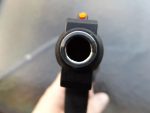
The ol’ fashioned revolver isn’t dead; it’s far from it . It is still a viable choice in a handgun for self defense use in the big city. It is easily concealed, with the right holster, and as always carry a spare reload even if it is on rubber speed strips. A revolver also has an easy manual of arms. Load the cylinder, close it, and all you need to do is take aim and pull the trigger. There is very little to go wrong with a revolver, compared to a seminauto loading handgun. In many cases, a revolver is a lot less money than a semiauto handgun. The little Taurus Model 85 Polymer Protector is selling for around $300 in my neck of the woods. Add in, that Taurus also has a lifetime warranty and they offer a free one year membership in the NRA, what’s not to like here?
If you’re in the market for a good ol’ fashioned, but up-to-date revolver, check out the Polymer Protector. I think you’ll like it.
– Senior Product Review Editor, Pat Cascio










